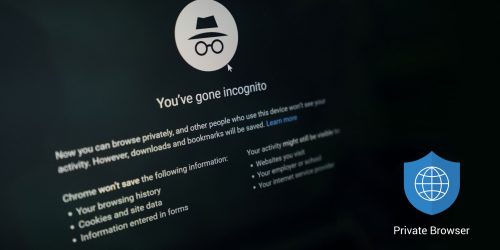
Of Anonymous Browsing, Incognito Mode in Chrome, and Alternative Browsers
Reading Time: 6 minutesContents
- Why Do You Need Private Browsing and How to Browse Incognito?
- How to Browse Incognito in Chrome and Alternative Browsers?
- Private Browser – Secure and Anonymous Alternative to Chrome and Firefox Incognito Modes
- Conclusion on Incognito Modes and Alternative Browsers
Oh the internet… Truly the land of the free and the home of the brave. It allows us to enjoy world’s finest content while staying incognito if need be.
Or, at least, it used to be this way. Nowadays, the internet is in its pre-industrial stage. In that, we’re seeing more and more attempts to regulate and bureaucratize the world wide web, make it more surveillable and controllable.
Whether this is a positive or negative trend is up for debate. Arguments can be made both ways – for instance, “online anonymity protects freedom of speech” VS “online anonymity facilitates cyber bullying”. Today, we’re not here to polemize on this topic, but to answer the question – how to browse incognito if you need to?
Browse truly incognito with anonymous Private Browser
Why Do You Need Private Browsing and How to Browse Incognito?
First things first, let’s look into the reasons that make netizens turn to incognito browsing. What problems exactly does it solve? What are the major threats to our privacy and anonymity online?
Government, Corporate, and ISP Surveillance
We’re living in the age of constant online surveillance. The Government is monitoring the web in search of forbidden data or malefactors; corporations like Facebook and Google are amassing immense amounts of data; smaller companies are using this data to target their ads at potential clients; and even at this very moment your internet service provider (ISP) is collecting all sorts of detailed information on you.
Not much anonymity to see here! In theory, however, all this is supposed to improve the quality of our lives. States can better protect their citizens, and companies can hand-tailor their products and services to meet your specific needs.
But then, as the theory meets practice, we get to witness a grimmer picture. Authorities tracking and deanonymizing independent journalists and opposition; Facebook – Cambridge Analytica scandal; ISPs selling their users’ info to whomever pays more. Willing or not, this can make anyone consider using an incognito private browser, don’t you think?
Modern, Elaborate Data Theft Techniques
Evolution of cyber crime and its countermeasures is not dissimilar to an arms race. Both sides are constantly trying to come up with new ways to accomplish their goals, and yet even the best solutions only work for so long. This is a vicious cycle, sure, but for common users, it’s still possible to stay ahead of the loop.
For any netizen concerned about their online protection, it is crucial to constantly keep their ear to the ground. The moment you settle on a security solution that’s effective against a single type of threat is the moment you open the backdoor to your data for every other danger.
Paraphrasing Caesar, diversify and counter should be your motto in fighting off cybercrime. That is, diversify your means of protection and choose the ones that counter specific contemporary threats (such as the internet incognito mode VS spyware).
Bandwidth Throttling by ISPs
Not only do some internet service providers collect their clients’ data to sell it, but many also use it themselves. The most common application, for instance, is to discriminate users who failed to make their browsing incognito.
Here is how it works. Based on the profile the ISP had built on a user, they may decide that this particular person is more likely to buy a more expensive type of subscription. So the ISP starts throttling the user’s bandwidth, artificially restricting their connection speed. As the person is trying to figure out the problem, they will of course be advised to boost their speed by purchasing a faster subscription. PROFIT!
Content Geo-Blocking by Content Providers (and Others)
Similar to ISPs, internet content providers can affect your online freedom as well. We’ve all seen YouTube’s This video is unavailable in your country messages, so you know what we’re talking about. This feels especially unfair when you’ve paid for the service only to find mere shreds of its functionality available in your region.
But it’s not always the content providers who are to blame. Sometimes, the government of the state decides to restrict its citizens access to certain products or services (the most common examples are pornography or “ideologically harmful” content). Whatever the case, only by browsing incognito can one hope to bypass such geo-blocking.
How to Browse Incognito in Chrome and Alternative Browsers?
So, what can a common netizen do if they wish to preserve their online freedom and browse the internet anonymously? There are two major options.
First, you can go into incognito mode in Chrome, Firefox, or whatever mainstream browser you’re using. Second, you could use an alternative browser that was specifically designed with the user’s privacy and anonymity in mind. Let’s take a look at both options, as well as their pros and cons.
How to Go Into Incognito Mode in Chrome
Incognito mode in popular browsers is a simple, easy to use, ad hoc solution. Works well for when you have an occasional need to browse the web semi-anonymously. In this mode, your browsing history, cookies and site data, and other information are not saved by your browser.
A huge disadvantage of this method, however, is that it is nowhere near the true anonymity. Your personal data and activities are still visible to the websites you visit, the managers of your network, and your ISPs.
To go into incognito mode in Chrome, either open the browser menu ![]() and click New Incognito Window, or press the respective key combination (e.g., Ctrl+Shift+n on Windows or ⌘+Shift+n on Mac). In the newly opened browser window, every tab you create will be an incognito one.
and click New Incognito Window, or press the respective key combination (e.g., Ctrl+Shift+n on Windows or ⌘+Shift+n on Mac). In the newly opened browser window, every tab you create will be an incognito one.
Alternatives to Chrome and Firefox
What exactly are the alternative browsers? To get a deeper understanding, check out our article about major and alternative browsers. For the sake of our today’s discussion, however, an alternative browser is any browser other than the five most popular ones – Google Chrome, Safari, Mozilla Firefox, Internet Explorer/Edge, and Opera.
When Do You Need Alternative Browsers?
There are plenty of alternative web browsers out there to suit every taste and budget. For a bit of an extreme example, did you hear about surf – a minimalist web browser with no graphical control elements in its user interface? Go figure!
To compete with the mainstream browsers like Chrome, alternative browsers have to focus on certain aspects, find their niche. So why would you want an alternative browser? When your needs are in its niche! In our case, the niche is the online privacy and anonymity, and the alternative browser is Private Browser.
Private Browser – Secure and Anonymous Alternative to Chrome and Firefox Incognito Modes
Private Browser was developed by KeepSolid, the company with over 5 years of experience in the field of cyber security and online anonymity. No big surprise, this neat mobile browser app for iOS and Android encapsulates all this experience. Its capabilities include:
-
Ensuring the Privacy of your Cyberlife
With Private Browser, your internet actions are nigh invisible. Your connection to websites will be established via a VPN server of your choice, masking your real IP address, anonymizing your activities, and making it impossible for anyone to build an extensive online profile on you.
-
Bypassing Content and Website Geo-Blocking
Here is where Private Browser’s VPN servers will come in handy once again. Whenever you find a video, social network, online service, or whatnot, restricted in your location, simply connect to a different VPN server. If it’s located in a country where the content in question is available, you’ll gain access to it too.
-
Protecting Personal Data and Sensitive Information
All online traffic that goes through Private Browser gets enciphered by AES-256 encryption. This military-grade protocol ensures that the users’ personal data and sensitive information is protected from any unauthorized parties. Be it a hacker, an ISP, or a government agent, they simply won’t be able to decipher and read your info.
Conclusion on Incognito Modes and Alternative Browsers
As you can see, browsing incognito is not that difficult. While you will have to decide what level of anonymity is sufficient for you, the implementation itself is easy. Regardless of whether you choose to browse in incognito mode of a mainstream browser, or to opt for an alternative solution, we wish you a secure, private, and anonymous cyber journey.




Ed Mason
May 1, 2019 - 8:10 PM
I have used Private Browser with my IPad for a while now Does my subscription allow me to protect my Windows computer and Android mobile phone too. How do I do that?
KeepSolid
May 3, 2019 - 12:43 PM
Hi Ed,
Thanks for choosing Private Browser! It’s currently available only for iOS and Android devices. To protect your browsing on Android mobile, just install the app, and sign in using your existing KeepSolid ID. Then connect to a VPN server and browse the web as securely as you do on your iPad!